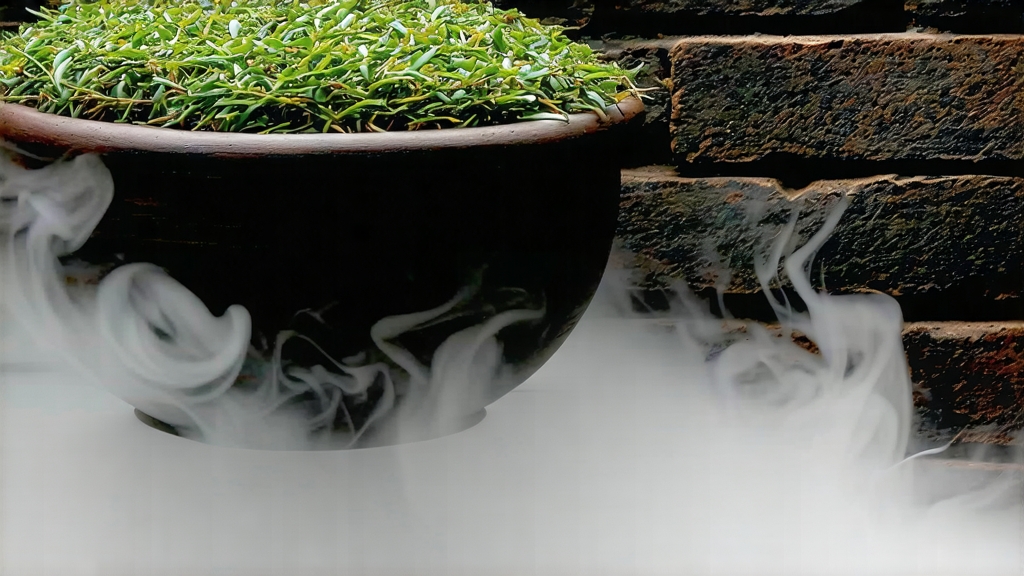
Tucked into the humid folds of southern China’s Guangxi Zhuang Autonomous Region, Liu Bao tea has spent four centuries quietly perfecting the art of subtle power. While Pu-erh has become the global shorthand for Chinese dark tea, Liu Bao remains the insider’s secret: a tea that once traveled the Ancient Tea-Horse Road southward to the ports of Guangdong and then on to Hong Kong, Singapore and Kuala Lumpur, where dock workers brewed it thick and sweet to cut through the salt air. Today the same tea is being rediscovered by specialty buyers from Brooklyn to Berlin who crave the deep, camphor-bright sweetness that only Liu Bao can deliver.
Historical records first name Liu Bao during the Ming dynasty Wanli era (1573-1620), when local gazetteers list it among “tribute goods” sent northward to the imperial court. The tea left the mountain town of Liubao in six-bamboo baskets called long bian—literally “dragon baskets”—each lined with banana leaf and pressed with stones so the tea would arrive at the Pearl River delta already half-fermented by the heat of the journey. That accidental micro-climate turned out to be the perfect incubator for the mellow, betel-nut fragrance that later became the style’s signature. By the late Qing, Liu Bao accounted for more than half of Guangxi’s export revenue, paid for in silver taels and carried on the backs of porters who could cover twenty kilometers a day through karst gorges alive with cicadas.
Liu Bao is not a single cultivar but a processing method applied to a local population of medium-leaf Camellia sinensis var. sinensis that has adapted to the red lateritic soils of the Dayao Mountains. Growers recognize three traditional leaf grades—gua zi (melon seed), gua pian (melon slice) and li ye (plum leaf)—based on the length and curvature of the freshly picked shoot. The highest grade, gua zi, uses only the first two leaves and the unopened bud, plucked in the mist-cooled window between Qingming and Guyu when the mountain humidity hovers at 85 %. After picking, the leaves are spread on bamboo mats inside ventilated wooden sheds where they wither for eight to ten hours, losing roughly 30 % of their moisture while absorbing the scent of surrounding cinnamon and star-anise trees.
The kill-green step is brief but decisive: leaves are tossed in iron woks heated to 200 °C for less than three minutes, just long enough to denature the leaf enzymes without sealing the surface. What follows is Liu Bao’s hallmark “wet pile” fermentation, a controlled cousin of the composting process that gives Pu-erh its color. The partially dried leaves are piled 70 cm deep on cement floors, sprayed with mountain spring water, and covered with jute sacks. A thermophilic microbial community dominated by Aspergillus niger, Blastobotrys adeninivorans and local strains of Bacillus subtilis raises the core temperature to 55 °C within 36 hours. Every 24 hours the pile is turned by shovel, aerating the mass and re-distributing moisture so that no leaf spends too long in the anaerobic core. After seven to ten days the leaves emerge the color of rusted iron, their catechins converted to theaflavins and gallic acid, their cellulose partially hydrolyzed to simple sugars that will later translate into a honeyed thickness on the palate.
Post-fermentation, the tea is steamed for twenty seconds, pressed into 50 kg bamboo baskets lined with dried banana leaf, and transferred to underground caves carved into the limestone hillsides. The caves maintain 22–24 °C and 85 % relative humidity year-round, allowing a slow secondary fermentation that can last anywhere from three to thirty years. During this time the baskets are rotated every six months so that each brick absorbs moisture evenly, developing the prized “golden flowers”—Eurotium cristatum—that appear as yellow freckles on the leaf surface and impart a faint dried-apricot note.
Modern Liu Bao is also produced in compressed 100 g mini-bricks and 250 g discs for the urban market, but connoisseurs still seek the cave-aged baskets, identifiable by the white crystalline bloom of amino-acid complexes that glint like frost under LED light. A 1996 basket recently sold at auction in Guangzhou for USD 18,000, its liquor the color of black cherry and